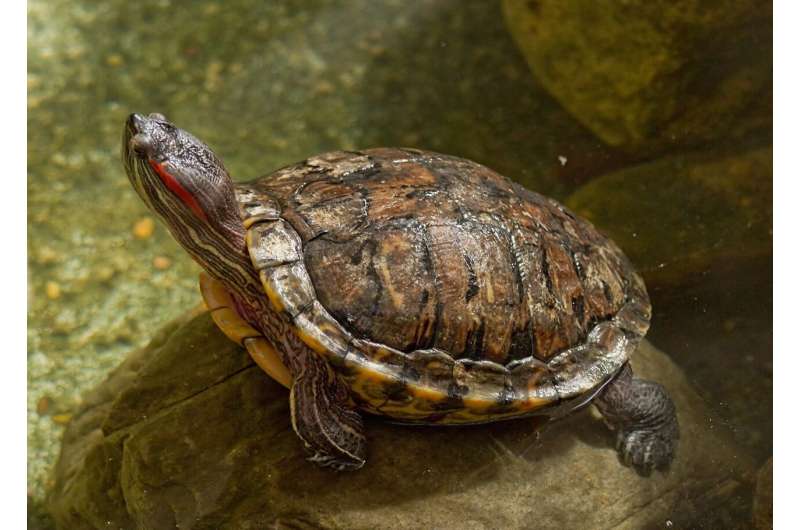This article has been reviewed according to Science X's editorial process and policies. Editors have highlighted the following attributes while ensuring the content's credibility:
fact-checked
peer-reviewed publication
trusted source
proofread
New finding suggests how and why temperatures determine the sex of turtles

Warmer temperatures are known to make more turtle eggs become female hatchlings, but new research out of Duke University shows that those females also have a higher capacity for egg production, even before their sex is set.
This finding may explain why many animals besides turtles have temperature-dependent sex determination and why the system persists, despite seeming like a risky strategy. It may also provide a troubling glimpse of what could lie ahead in a warming world.
What the researchers found, as published June 23 the journal Current Biology, is that the number of "germ cells"—pre-eggs—that an embryo carries is increased by higher incubation temperatures. In fact, they found that those germ cells themselves play a role in the embryo becoming female.
"Sex determination by temperature isn't just one mechanism," said senior author Blanche Capel, the James B. Duke Distinguished Professor of Cell Biology in the Duke School of Medicine. "Higher temperatures seem to affect sex determination in incremental ways through multiple cell types in the embryo."
The more abundant germ cells themselves seem to drive feminization, said Boris Tezak, a postdoctoral researcher in the Capel lab who led this project. "The temperatures that produce females are also the temperatures that increase germ cell number," he said.
Higher numbers of germ cells are known to control female development in fish as well, Capel said. But to prove the point that more germ cells lead to female turtles, they removed some germ cells from red-eared slider embryos raised at an intermediate temperature that should have yielded 50-50 proportions, and saw more males than expected.
Scientists have known about temperature-dependent sex development for decades and have found it in many different parts of the tree of life, apparently because it evolved multiple times in multiple ways.
"It popped up everywhere," Tezak said. "It seems like a really risky strategy, especially in the context of weather variations and climate change, so why would this system persist?"
They think it's because temperature-dependent sex development creates a reproductive advantage.
"A female that hatches with more germ cells is presumably more reproductively fit—it increases her reproductive potential to carry more eggs," Tezak said. "We've linked the female pathway to the increased number of germ cells, and if that does make her more reproductively fit, that would go a long way toward explaining why temperature-dependent sex development persists."
As global temperatures continue to rise, the question becomes: what will happen to the turtles and other temperature-sensitive breeders? "We'll be looking at how further increases in temperature will affect the pool of germ cells," Tezak said. "Will it produce less-fit females?"
To answer these questions, Tezak carefully nurtures clutches of red-eared slider eggs obtained from a Louisiana breeder in plastic boxes filled with moist medium and kept at a constant temperature in the lab. One incubator runs at 26 degrees Celsius, producing more males. Another is at 31 degrees, the optimum temperature for producing more females.
When he takes out one of each to check on their progress with a very bright light, the embryo that was incubated warmer is markedly larger and more active inside the egg.
"We are hypothesizing that there's a temperature 'sweet-spot,'" Capel said. "There is a short range where you get a large number of germ cells, and beyond that you start to see declines," Capel said.
"We have incubated some eggs at 33.5 degrees, only two and a half degrees higher than the optimal temperature for females," Tezak said. "It created some really wonky embryos—there were cyclops and two-headed embryos. We haven't counted their germ cells yet."
The lab is also about to take delivery on some alligator eggs to continue the temperature experiments. Alligators are known to produce females at low temperatures and males at high temperatures, the opposite pattern from the red-eared slider turtle. However, the low temperature in alligators is the same as the high temperature in turtles, so both species produce females at 31 degrees Celsius. "The interesting question is whether we see more germ cells in both species at this temperature," Tezak said.
More information: B. Capel, Higher temperatures directly increase germ cell number which promotes feminization of red-eared slider turtles, Current Biology (2023). DOI: 10.1016/j.cub.2023.06.008. www.cell.com/current-biology/f … 0960-9822(23)00758-3
Journal information: Current Biology
Provided by Duke University




















